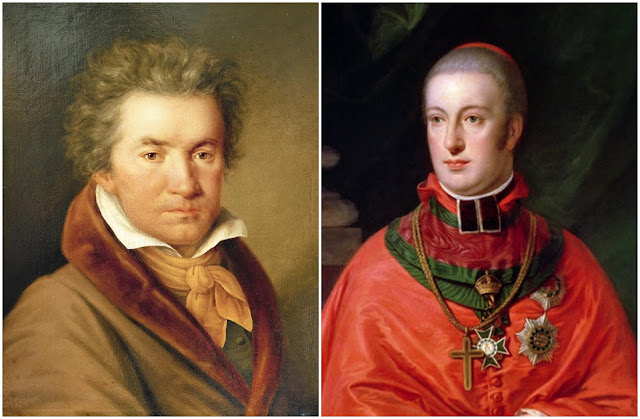Composed 1809-10; 18 minutes
Beethoven portrays feelings rather than narrative in his 1810 sonata, often known today by its French title Les adieux. The French title has stubbornly stuck ever since Beethoven’s publisher, Breitkopf & Härtel, issued the work in both French and German editions. The German title Das Lebewohl is the more evocative since this is the word (‘Le-be-wohl’) that Beethoven writes over the three slow hunting horn calls that open the work. The word means ‘farewell’ and the movement marks the departure and temporary exile of his friend and patron. The word ‘Lebewohl’ means something quite different from ‘Les adieux,’ Beethoven informed his publisher. “The first is said in a warm-hearted manner to one person, the other to a whole group of people, or to a town,” he added.
Although the sonata clearly has a descriptive program, Beethoven steers clear of portraying bombardment or foot soldiers in the streets. The sonata deals in human terms with (as the movement headings indicate) the departure of, absence from and reunion with a friend. It's ‘more feeling than painting,’ as Beethoven said of the program to his Pastoral Symphony. Many of the themes of the three movements spring from that lamenting opening horn call and the rising figure that immediately follows. The distantly echoing horn calls in the closing measures of the first movement suggest a picture of the young Archduke’s coach and horses receding into the distance as the royal household flees Vienna for Buda in Hungary. ‘Absence’ and ‘The Reunion’ lead Beethoven to the minor and then major keys, the latter bursting out of the restless, shifting harmonies of the slow movement as a shout of joy, its melody now jubilantly recalling the opening horn-call ‘Farewell’ motif.
The composer and his Farewell
 Archduke Rudolph of Austria (1788-1831) was the youngest son of Emperor Leopold II and brother of Emperor Franz. Rudolph was a fine pianist and diligent student of composition, having been Beethoven’s pupil since 1804, when he was 15 or 16. Under the composer’s direction he completed some 25 works, making him Beethoven’s only serious composition student. Beginning with the Farewell sonata, Rudolph was to receive more dedications than any other patron – including the Missa solemnis, Fourth and Fifth Piano Concertos, the Hammerklavier and Op. 111 Piano Sonatas, the Violin Sonata Op. 96, Trio Op. 97, and Grosse Fuge.
Archduke Rudolph of Austria (1788-1831) was the youngest son of Emperor Leopold II and brother of Emperor Franz. Rudolph was a fine pianist and diligent student of composition, having been Beethoven’s pupil since 1804, when he was 15 or 16. Under the composer’s direction he completed some 25 works, making him Beethoven’s only serious composition student. Beginning with the Farewell sonata, Rudolph was to receive more dedications than any other patron – including the Missa solemnis, Fourth and Fifth Piano Concertos, the Hammerklavier and Op. 111 Piano Sonatas, the Violin Sonata Op. 96, Trio Op. 97, and Grosse Fuge.
Rudolph was already a leading patron when, in 1809, he joined the Princes Kinsky and Lobkowitz in providing Beethoven with an annuity of 4,000 florins to ensure the composer remained a citizen of Vienna, and not accept an appointment as Kapellmeister in Kassel. Later that year, with Napoleon’s troops beginning their siege on Vienna, Rudolph and the Imperial family had to flee the capital, prompting Beethoven to write tonight’s opening work.